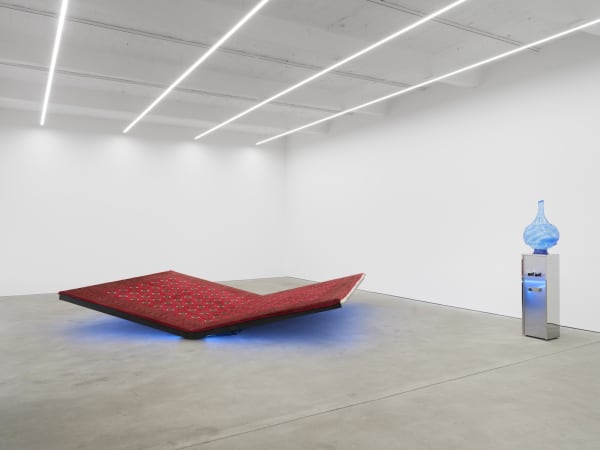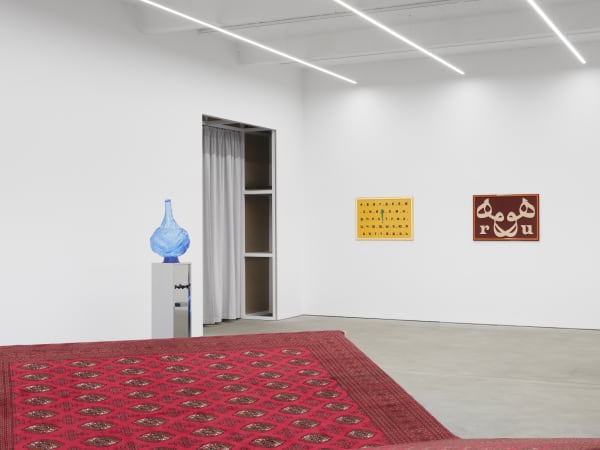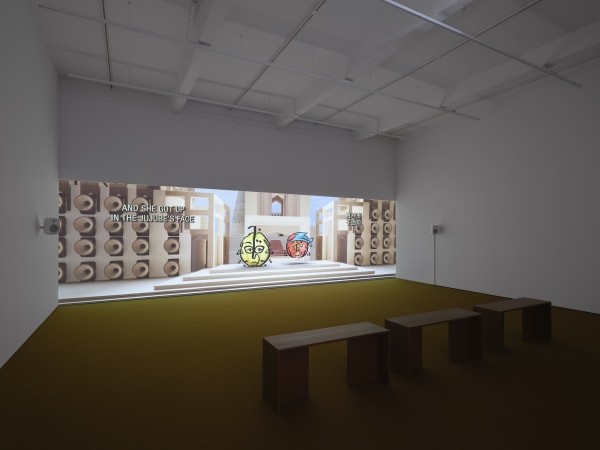The Contest of the Fruits: SLAVS AND TATARS
-
 SLAVS AND TATARS, The Contest of the Fruits, Kraupa–Tuskany Zeidler, Berlin, 2024
SLAVS AND TATARS, The Contest of the Fruits, Kraupa–Tuskany Zeidler, Berlin, 2024 -
 SLAVS AND TATARS, The Contest of the Fruits, Kraupa–Tuskany Zeidler, Berlin, 2024
SLAVS AND TATARS, The Contest of the Fruits, Kraupa–Tuskany Zeidler, Berlin, 2024 -
 SLAVS AND TATARS, The Contest of the Fruits, Kraupa–Tuskany Zeidler, Berlin, 2024
SLAVS AND TATARS, The Contest of the Fruits, Kraupa–Tuskany Zeidler, Berlin, 2024 -
 SLAVS AND TATARS, The Contest of the Fruits, Kraupa–Tuskany Zeidler, Berlin, 2024
SLAVS AND TATARS, The Contest of the Fruits, Kraupa–Tuskany Zeidler, Berlin, 2024 -
 SLAVS AND TATARS, The Contest of the Fruits, Kraupa–Tuskany Zeidler, Berlin, 2024
SLAVS AND TATARS, The Contest of the Fruits, Kraupa–Tuskany Zeidler, Berlin, 2024
The Contest of the Fruits, Slavs and Tatars’ first animated film, takes a satirical 19th century Uyghur poem as a starting point for investigations of language, politics, religion, humor, resilience and resistance, in the form of a rap battle between various fruits.
The original poem, The Contest of the Fruits, written in verse and equipped with proverbs and aphorisms, stages a form of verbal dispute (or munāẓara) and has been translated into English for the first time by Gunnar Jarring in 1936. Nash Tarr, a rapper hailing from the Uyghur diaspora, delivers a performance of the original soundtrack of Slavs and Tatars’ animated movie, where the words take shape within the dynamic context of a rap battle, with pop, trap and maqam elements, mixed by Polish musician Lubomir Grzelak. Thirteen fruits, from the mulberry to the pomegranate, the quince and the jujube, engage in an ironic oratorical joust. The fruit's individual physiognomy is shaped after its respective Uyghur name, rendered in Arabic calligraphy. The film reveals the richness of Uyghur culture, syncretic, linguistic and ethnographic heritage that make up Uyghur identity.
The Contest of the Fruits was developed by the collective during their residency at The Hurford Center for the Arts and Humanities, Haverford College and The Pew Center for Arts & Heritage, Philadelphia (US) in 2021. It has been shown at Basement Roma (2023), Centre Pompidou, Metz (2022), and Cantor Fitzgerald Gallery, Haverford (2021).
The eponymous exhibition takes the visitor to encounter one of Slavs and Tatars’ paradigmatic works, PrayWay (2012) in the first gallery space. The social sculpture offers a contemplation and materialization of books and reading. Since their beginnings as a book club in 2006, publications have been at the core of the collective’s activities. PrayWay refers formally to the rahlé, a traditional bookstand common to Central Asian Islam for holy books and the takht or topchan, what the collective calls RiverBed–in honor of its ideal placement by a source of water found at teahouses, roadside kiosks and at the entrances of mosques across Iran and Central Asia. PrayWay is a typical example of Slavs and Tatars’ participatory, relational works, creating a space for conversations, and intercultural communication.
Salamoia (blue), resembles a cosmic watercooler, wherein the water container has been replaced by an amameh, or turban, underlining the discursive role of thirst in the foundations of Shi’a symbolism. Water-fountains are often found outside Shi’a shrines and mosques, as votive and ritual sources of water in homage to the 7th century Battle of Kerbala in the desert where dehydration played a major role. The work was part of the collective’s installation Dillio Plaza at the 58th Venice Biennale.
Who are you (2021) and The Alphabet (Uyghur kril yéziqi), 2021 explore the linguistic phenomenon of transliteration, the conversion of scripts, framed by the slippages occurring in phonetics, semantics and theology. Belonging to the Tranny Tease work series (2009-ongoing), they examine alphabet politics and mistranslations by employing the 'wrong' or inappropriate script for a given text.
Using the Arabic word for 'He,' often gendered as masculine to express the Divine, Who are you poses the existential question as one not only between secular and holy but also between the various normative gender variations of the former and latter. The Alphabet (Uyghur kril yéziqi) revisits Marcel Broodthaers’ Poèmes industriels, replacing the Latin alphabet with an Cyrillic one, one of three alphabets used for Uyghur in the 20th century. The original exclamation of ‘OK!’ survives unscathed, despite the transmogrification from the secularized world of Latin.
In their humorous, but in-depth researched-based works, Slavs and Tatars affirm that language, rituals and commodities have consistently traversed geopolitical boundaries. Within their practice, the collective explores more entangled levels of regionality, through history, religion, interpretative authority and the performative and political nature of language and identity, retaining cultural specificities often lost in larger categories such as globalism.
SLAVS AND TATARS
founded 2006, Eurasia
Slavs and Tatars is an internationally renowned art collective devoted to an area East of the former Berlin Wall and West of the Great Wall of China known as Eurasia. Since its inception in 2006, the collective has shown a keen grasp of polemical issues in society, clearing new paths for contemporary discourse via a wholly idiosyncratic form of knowledge production: including popular culture, spiritual and esoteric traditions, oral histories, modern myths, as well as scholarly research.
The collective’s practice is based on three activities: exhibitions, publications, and lecture-performances. The collective has published more than twelve books to date, including most recently Лук Бук (Look Book) with Distanz Verlag. In 2020, Slavs and Tatars opened Pickle Bar, a slavic aperitivo bar-cum-project space a few doors down from their studio in the Moabit district of Berlin.
Slavs and Tatars participated in the 58th Venice Biennale (2019).
Solo exhibitions have taken place at West, The Hague, (2023); Basement Roma, Rome (2023); Tanya Bonakdar Gallery, Los Angeles (2023); Kraupa-Tuskany Zeidler, Berlin (2023); M HKA, Antwerp (2023); Humboldt Forum, Berlin (2022); Hacernoche, Oaxaca (2022); Neubauer Collegium Gallery, Chicago (2022); Cantor Fitzgerald Gallery, Haverford (2021); Kunsthalle Osnabrück (2021); Hayward Gallery, London (2021); Pinakothek der Moderne, Munich (2021); Villa Arson, Nice (2020); Gallery «y», Minsk (2019); Kunstverein Hannover (2018); Albertinum, Dresden (2018); Westfälischer Kunstverein, Münster (2018); CAC, Vilnius (2017); Museum of Contemporary Art Belgrade (2017); Salt Galata, Istanbul (2017); Pejman Foundation, Tehran (2017); Center for Contemporary Art, Warsaw (2016).











